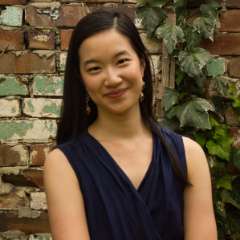Opera Australia opened 2020 by reprising Gale Edwards’ Berlin-based La bohème. Inspired by the last days of the Weimar Republic, this Opera Australia favourite has been regularly rolled out since 2011 (this time directed by Liesel Badorrek). It’s easy to see why: it's Puccini’s perennial classic and swathes of 1930s spectacle.
Visually it packs a punch, with Brian Thomson’s lively sets, Julie Lynch’s detailed costuming, and John Rayment’s sensitive lighting. In Edwards' world, our bohemians inhabit a dramatic double-storey garret, where Marcello’s Red Sea painting isn’t the usual canvas-on-easel, but a giant Art Nouveau mural climbing the walls. Its creator sings from atop his painting ladder.
But it’s the crowd scenes that really shine, aided by a turntable stage that dizzyingly evokes the era's whirlwind hedonism. The Latin Quarter is a green-and-brown jumble of shrieking hawker children, darting between the legs of stilt walkers peddling glittering wares from long, bright coats. Act 2’s Café Momus is a fairy-lit cabaret club, draped with red velvet, jet-eyed dancing girls, and plumes of cigar smoke. A white spotlight drops centre stage. Musetta appears, looking like Marlene Dietrich channelling Madonna. A vintage microphone is placed before her and, raising her gloved arms into a cabaret pose, she begins “Quando me'n vo'”.
Moments like these work best in Edwards’ Bohème. But delve past the aesthetic, and the Weimar setting feels a bit superficial. None of it seems to impact the characters. It’s unclear why Act 3’s tollgate looks like a work camp or ration queue. Nazis make the odd cameo appearance amongst the chorus, but their presence is merely tokenistic. And with political commentators questioning whether our times bear more than a passing resemblance to Weimar days – with dramatic turns in world politics, immigration tensions, and capitalist excess looming on public consciousness now as they did then – it’s a pity the setting’s complexities aren’t more vividly realised.
At heart though, La bohème draws audiences through its characters, and Edwards’ production is compelling in its human story. The cast was strong, with Australian-Chinese tenor Kang Wang making his Opera Australia debut as Rodolfo. A former Met Opera Lindemann Young Artist, and a finalist in the 2017 Cardiff Singer of the World competition, Wang is a rising star. His tenor was bloomingly even-toned, with a plush, dark lower register and a soaring top. He has an extremely pleasing sense of phrasing, shown in his “Che gelida menina”, and his Rodolfo seemed like a sincerely nice man – the sort of Rodolfo an audience could get behind.
His long-suffering housemate Marcello was Samuel Dundas, singing with both fervour and thoughtfulness. Michael Lampard’s Schaunard was a flamboyant, witty stage presence, and Richard Anderson reprised his earthy Colline. His poignant Act 4 “coat aria” carried genuine pathos. These four men excelled in their garret scenes together, drawing audience laughter with solid theatrical camaraderie and satisfying ensemble singing.
Dundas had good on-stage chemistry with his Musetta, Julie Lea Goodwin. Experienced in the role, she sang with her usual polished ease and her sparkling "Musetta's Waltz" was a highlight of the evening. Her dance ability was a real asset in bringing the cabaret era to life, with Goodwin weaving her way through café tables so that her legs did as much suggesting as her assured soprano.
I had a hard time warming to Karah Son’s Mimì. In recent years Son has sung to acclaim Cio-Cio-San for Opera Australia in two separate incarnations of Madama Butterfly, and Liu in Turandot. I can’t help wondering if those noble, slightly distant characters suit her on-stage persona more than Mimì, especially given the metallic edge to her voice. While there’s no doubting her vocal prowess – the steely overtones, effortless power, and masterfully-controlled pianissimo – her Mimì rarely sang to Rodolfo or to the audience, and had little sense of character. It was all a bit inward-looking and distant, especially against the rest of the cast’s warm, natural style. Not that the audience really cared, so clearly were they enamoured with her sound.
Carlo Goldstein led the Opera Australia orchestra with energy, and the chorus and children’s chorus were similarly lively.
Finally, I should mention that Australia’s current bushfire crisis is so unprecedentedly extreme that on opening night, the Opera House was wreathed in ashy smoke haze and the audience coughing outdid Mimì's. Such environmental conditions aren’t easy on singers, who deserve extra applause for gifting us with wonderful sound regardless, and transporting audiences to an opera whose curtain opens on a cold, snowy night.




